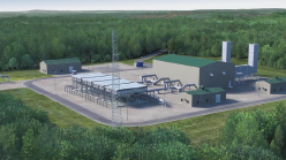Background
New and proposed changes in air emission regulations are likely to impact the interstate natural gas transportation industry. Regulations that are expected to impact the industry include the ozone National Ambient Air Quality Standards (NAAQS) and the nitrogen dioxide (NO2) one hour NAAQS. Since nitrogen oxides (NOx) react in the atmosphere to form ozone, it is regulated as a precursor to ozone. As emission control rules are developed and permitting actions implemented in response to these federal standards, there will be ongoing pressure to reduce emissions of NOx from existing equipment that has not yet been impacted by NOx control rules, or has been minimally impacted. For example, EPA and states have not yet implemented permitting requirements related to a recent revision to the NO2 NAAQS. In addition, due to lawsuits and evolving EPA policy, states have been passive in recent years regarding the next set of rules to reduce NOx to address ozone NAAQS concerns. In response to a new ozone NAAQS planned for 2015, there is a potential for broad NOx controls in the eastern half of the U.S. to address NOx transport. Along with the revised ozone NAAQS and implementation of the NO2 NAAQS, upcoming court decisions, including a Supreme Court decision on EPA authority to institute regional NOx rules, will likely break the regulatory logjam.
Based on these expected air regulation changes that result in new requirements to reduce NOx from existing equipment, a significant number of stationary engines that drive natural gas compressors in interstate natural gas transmission service will likely require modification to meet new federal or state NOx rules or permitting requirements. Based on current technical resources, the projected time to implement retrofit NOx control (or replacement) is far in excess of typical regulatory schedules.
The focus of the research for this report was to evaluate the resources required of the operating companies, emission reduction suppliers, engineering service providers, and contractors to implement NOx control regulations for low speed reciprocating engines used in the interstate natural gas transportation industry. The information gathered in developing this report included input solicited from both operating companies and vendors who provide emission reduction retrofit equipment. The assessment included an evaluation of an industry database to estimate the number and type of engines that would be impacted by changes to the emission regulations. Resource and schedule requirements assessed in this report are based on the actual fleet (i.e., make, model, NOx control status) from that database.
Introduction
As shown below, air emissions from a natural gas compressor station are regulated by a complex web of federal and state regulation. This report focuses on the potential availability of resources – equipment, people, and expenditures – needed to modify these compressor stations to meet possible NOx emission requirements.
Air emissions continue to be a major regulatory issue, and air quality regulations pose a risk to normal operations of existing natural gas transmission infrastructure. NOx emissions are the primary air pollutant of interest from natural gas-fired combustion sources. NOx can react in the atmosphere to form ozone, so NOx is regulated as a precursor to ozone. NOx can also react to form nitrates, and ammonium nitrate is an aerosol that comprises a portion of atmospheric fine particulate (PM2.5). The U.S. Environmental Protection Agency (EPA) establishes NAAQS for six criteria pollutants, including ozone, NO2, and PM2.5. NOx emissions are comprised of NO and NO2, but all NOx emissions are generally considered NO2 under the NO2 NAAQS.
Based on ambient air monitoring, if the air quality in a particular location does not meet (i.e., “attain”) the NAAQS, that geographical area will be designated as a “nonattainment” area. Then, state or local agencies are required to develop regulations that decrease emissions from existing sources to reduce ambient pollutant levels and attain the NAAQS. In addition, NOx emissions may be evaluated by regulatory agencies using a model that simulates the behavior of the exhaust plume (i.e., a “dispersion model”) to assess whether NO2 impacts beyond the compressor station fence line exceed the NO2 NAAQS. If so, mitigation would likely be required.
For example, NOx Reasonably Achievable Control Technology (RACT) regulations may be adopted by a state to address ozone nonattainment within the state. These rules may apply to limited in-state areas (e.g., urban nonattainment areas) or statewide. In addition, many urban and eastern U.S. areas have already reduced NOx emissions, but NOx transported from upwind states contributes to nonattainment. This phenomenon is referred to as “NOx transport,” and EPA may adopt multi-state regional rules to reduce NOx across the eastern U.S. and mitigate NOx transport. For natural gas-fired combustion sources, NOx is the primary pollutant that may be regulated by these rules. Emissions of other pollutants such as formaldehyde, which is regulated as a hazardous air pollutant (HAP), may also trigger emission controls. However, it is generally expected that existing catalyst control providers can meet demands to address new regulatory requirements.
Thus, this report focuses on potential resource constraints associated with regulations that require retrofit installation of NOx emission control technologies. More specifically, the report focuses on combustion-based technologies – i.e., low emissions combustion (LEC) – for lean burn reciprocating engines commonly used in interstate transmission and most likely subject to retrofit NOx control in the future (i.e., this older equipment is typically “grandfathered” and many units have not been subject to NOx regulations to date). The reciprocating engines of interest are low speed “integral” engines uniquely used for gas compression, where the compressor and its driver – i.e., the reciprocating engine used to power the compressor – are integrated into a single piece of equipment with a common crankshaft. These legacy integral engines comprise a large portion of the horsepower capacity in interstate natural gas compression and can also be found in gas processing and, to a lesser extent, in gathering compression. Although these engines have been in service for many years, because they were designed specifically to compress natural gas, natural gas-fired integral engines remain the most efficient option for gas compression.
Conclusion
There is a great deal of uncertainty about the breadth (i.e., how geographically broad), depth (i.e., stringency of the rule), and schedule for new NOx regulations that will affect existing natural gas-fired reciprocating engines. Litigation and scheduling delays have slowed the regulatory process. Although the timing and breadth of new NOx control regulations remains uncertain, it is likely that many of the natural gas-fired reciprocating engines in the existing prime mover fleet will require NOx control by 2025. There are several thousand legacy natural gas-fired reciprocating engines driving compressors in interstate transmission, and their location (i.e., in rural areas where emission rules are more rare) and history (i.e., operating prior to rulemakings that affect new equipment) make these engines candidates for future regulation.
Based on previous projects and interviews with industry experts, modifying these engines will require significant time and capital. The capital required to address the fleet of engines without low NOx technology is significant. In addition, the lack of available expertise is likely to be a primary constraint in addressing broad, new regulations on a timely basis.





